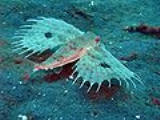
Oriental flying gurnard
Encyclopedia
The oriental flying gurnard, Dactyloptena orientalis, is a flying gurnard of the family
Dactylopteridae
. This flying gurnard inhabits the Indo-Pacific Ocean
s at depths to 100 metres (328.1 ft). Their name is derived from the French word 'gurnard' meaning to grunt, for the grunting sound this fish makes.
The oriental flying gurnard is up to 40 centimetres (15.7 in) in length and is usually a grayish brown color with dark markings. The fish has huge, round pectoral fins having many dark markings and a bright blue edge. The pectoral fins are normally held against the body, but when threatened the fins are expanded in to scare predators which include sea breams and mackerel
. The flying gurnard uses its pelvic fins to walk along the bottom of the ocean.
The oriental flying gurnard feed on bony fish, bivalves, and crustacean
s.
Family (biology)
In biological classification, family is* a taxonomic rank. Other well-known ranks are life, domain, kingdom, phylum, class, order, genus, and species, with family fitting between order and genus. As for the other well-known ranks, there is the option of an immediately lower rank, indicated by the...
Dactylopteridae
Dactylopteridae
The flying gurnards are a family, Dactylopteridae, of marine fish notable for their greatly enlarged pectoral fins. As they cannot literally fly, an alternative name preferred by some authors is helmet gurnards...
. This flying gurnard inhabits the Indo-Pacific Ocean
Pacific Ocean
The Pacific Ocean is the largest of the Earth's oceanic divisions. It extends from the Arctic in the north to the Southern Ocean in the south, bounded by Asia and Australia in the west, and the Americas in the east.At 165.2 million square kilometres in area, this largest division of the World...
s at depths to 100 metres (328.1 ft). Their name is derived from the French word 'gurnard' meaning to grunt, for the grunting sound this fish makes.
The oriental flying gurnard is up to 40 centimetres (15.7 in) in length and is usually a grayish brown color with dark markings. The fish has huge, round pectoral fins having many dark markings and a bright blue edge. The pectoral fins are normally held against the body, but when threatened the fins are expanded in to scare predators which include sea breams and mackerel
Mackerel
Mackerel is a common name applied to a number of different species of fish, mostly, but not exclusively, from the family Scombridae. They may be found in all tropical and temperate seas. Most live offshore in the oceanic environment but a few, like the Spanish mackerel , enter bays and can be...
. The flying gurnard uses its pelvic fins to walk along the bottom of the ocean.
The oriental flying gurnard feed on bony fish, bivalves, and crustacean
Crustacean
Crustaceans form a very large group of arthropods, usually treated as a subphylum, which includes such familiar animals as crabs, lobsters, crayfish, shrimp, krill and barnacles. The 50,000 described species range in size from Stygotantulus stocki at , to the Japanese spider crab with a leg span...
s.
External links
- Dactyloptena orientalis page at the Australian MuseumAustralian MuseumThe Australian Museum is the oldest museum in Australia, with an international reputation in the fields of natural history and anthropology. It features collections of vertebrate and invertebrate zoology, as well as mineralogy, palaeontology, and anthropology...
website. - Dactyloptena Orientalis entry at FishbaseFishBaseFishBase is a comprehensive database of information about fish species . It is the largest and most extensively accessed online database on adult finfish on the web...
.

